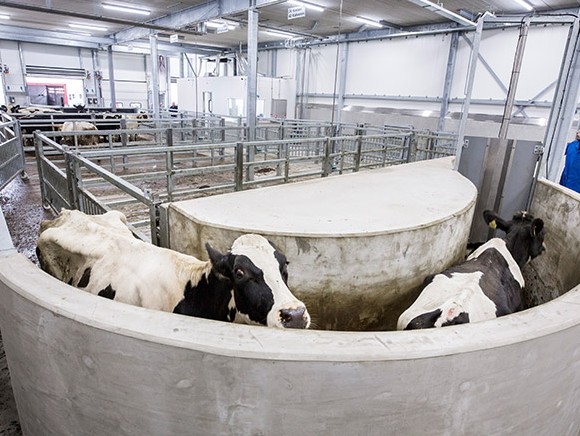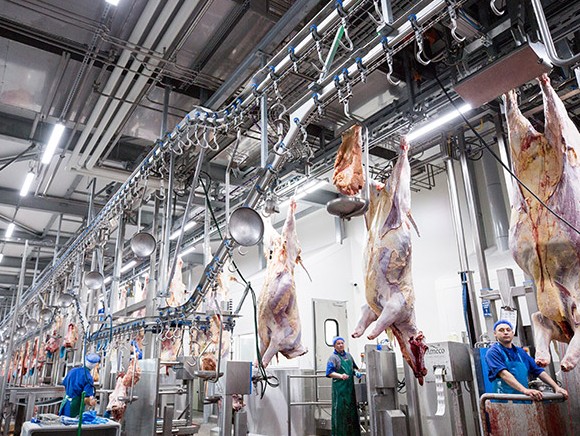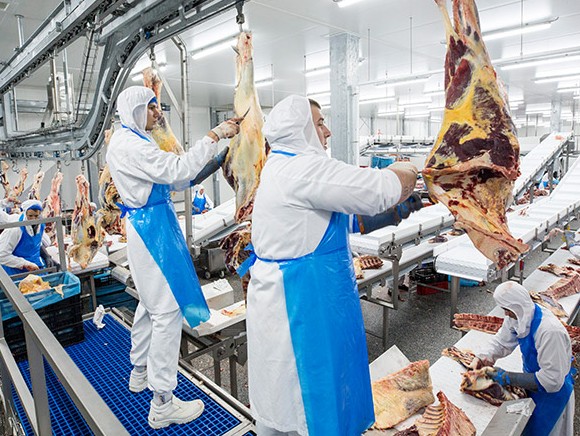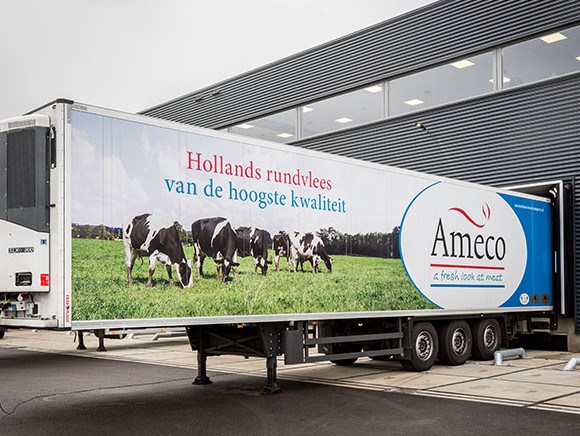
Ameco set itself the ambitious target of building a completely new slaughterhouse within the space of 13 months. By May of this year, the steel framework at the site on the Ecofactorij business park in Apeldoorn was 95% complete. Everything was finished by mid-October and – bang on schedule – the first trial slaughtering activities took place.
These were successful, and a week later Ameco (which stands for Amsterdam Meat Company) relocated from Amsterdam to Apeldoorn. The reasons for the move included the poor accessibility and redevelopment of the old site in Amsterdam-West. Traffic congestion hindered the delivery of livestock.
We visit Ameco for a tour of the Apeldoorn premises just four days after the move, and things are still on schedule. A few things still need fine-tuning here and there, but Director Jan Westreenen and his son Karel are very satisfied overall. Before long, the weekly production level will be over 1,500 cattle. Countless improvements – large and small – have been made to both the building and the processes, and they are already paying off. Jan: “I never dreamt that things would run so well so soon.” Karel adds, with visible pride: “By increasing the pressure and all rolling up our sleeves and getting stuck in, we pulled it off.”
All the spaces in the building – from the offices, holding pen and dispatch to the areas for slaughter, refrigeration, deboning and packaging – lead off from the large central hall, which makes the design (by architectural firm Bessels Architekten) unique. A large water tank has been installed outside which heats groundwater to 50 degrees Celsius. That achieves a 20-25% saving on energy costs.
An in-house temping agency takes care of the workforce planning, so Jan and Karel no longer have to concern themselves with that. A card-operated access system controls who can go where. It prevents employees working in the holding pen from accessing the clean areas, for example. “All the doors are secured,” says Jan. “Thanks to this system there’s no interaction between people from different zones, which is much better in terms of food safety. Each zone has its own canteen and own changing rooms and lockers. Everyone receives a clean overall when they arrive and they toss the dirty clothing into the chute when they leave. It’s very efficient.” Ruys Vloeren has supplied all the floors and stairs on the premises.
The efficiency starts as soon as the trucks carrying livestock arrive at the gate. All the paperwork must be completed before they can even access the premises. The dairy cattle, all of which come from Dutch farms, are immediately checked over by a Netherlands Food and Consumer Product Safety Authority (NVWA) vet, who has their own office on the premises.
“The new method for the cattle walkway is quite unusual,” explains Jan. “There is a blind bend in it and the floor slopes upwards slightly. This method is used successfully in the USA and I was immediately enthusiastic when I saw a video of it. The underlying theory is that a cow automatically becomes curious if it can’t see what’s round the corner, so it will walk forward of its own accord. That removes the element of force. A number of gates channel the cattle. The animals have already become used to such gates on the farms, so that helps to minimise their stress. We hardly have to drive the cattle at all here. I didn’t know for sure whether the blind bend along the walkway would really work, but I thought it could do no harm either. We’re trying to do all we can to make the process more animal-friendly so we’ve also opted for anaesthetic that can be controlled well.” Once the cows have been unloaded, there are three wash bays for trucks (compared to just one on the Amsterdam site). This speeds up the turnaround time too.

Constructing an insulation system
KIM Nederland supplied and installed the entire insulation system for Ameco’s new-build facility: 5,600m2 of exterior cladding, 3,500m2 of roof panels, 9,000m2 of interior walls and 3,900m2 of ceilings. “Thanks to the deployment of our own installation specialists we managed to complete the work in a very short space of time,” recalls Gerard Scherff, Sales Manager and Project Lead. “The high-quality sandwich panels that Ameco chose comply with the very highest standards. In the exterior wall, we made a cold-bridge-free attachment using factory-made foam-covered omega profiles – this is truly novel. This ingenious attachment method isn’t even visible on the outside, which creates a clean and attractive-looking facade. In addition to Ameco setting new standards with this, its slaughterhouse is also ready for the future.”
www.kim-nederland.nl
“The thing I’m most proud of is the routing in the building and the engineering, from top to bottom,” continues Jan. “At the new facility, one significant change is that the deboning work has become less strenuous for the employees. The whole line, from the live cow to the packaging line, comes from Frontmatec (formerly Nawi). The workspaces have been designed so that the work comes to the employees – they no longer have to walk alongside the conveyor or push carcasses away.” What is particularly striking is the good atmosphere on the line, from start to finish; the employees are working hard, but they don’t look tense. The pride is tangible during the guided tour.
The new slaughterhouse achieves better valorisation of the whole animal. Jan: “For example, most of the blood is now collected in such a way that it is fit for human use.” The slaughtering line is located on the first floor; all the by-products, and also the traceability, are included in the line. The conveyor has a bi-rail transport system and the hooks are attached to pulleys. “This rail does not require lubrication and its movement is extremely light. The hook sequence is guaranteed. To store the data about each animal correctly, all the hooks are fitted with chips and linked to the database,” explains Jan. The by-products of the slaughter process drop through chutes directly into an area beneath the slaughtering line; this helps to keep the floor clean. The meat and the by-products are kept strictly separate in different zones. The relevant slaughter time is followed by refrigeration and then slow cooling and sorting. “The red organs are immediately placed on a dry cooling conveyor to minimise the amount of handling here too. This conveyor carries the products directly to the packaging department downstairs.”

After the relevant cooling time, the carcass halves arrive in the cutting area, where Frontmatec has developed a combination of suspended deboning and pace deboning for them. Karel continues the guided tour and explains: “The carcasses and primal cuts are now easier for the employees to work with. A 300kg carcass will now be divided up into 15kg sections rather than 75kg ones. That makes the work less heavy-going, which means it can now be done by a wider group of employees.”
The process in the cutting area makes use of gravity wherever possible too. “The weighing is done automatically, the primal cuts that are removed from the carcass drop down onto the conveyor and then the line operatives process them into technical cuts. This approach results in fewer boxes and crates in the deboning area, plus the products always become available for packing in the same place.”
Whereas the Amsterdam facility needed a large number of butchers who were skilled in all aspects of deboning, here in Apeldoorn the line operatives each have their own specialisation. “We need fewer all-rounders now, which makes it a lot easier to find staff,” says Karel. However, he goes on to emphasise: “It’s still about craftsmanship because no two cows are the same; deboning is still a craft. An added advantage for us is that if we notice that something needs to be improved or corrected, it’s now easier to identify the person we need to speak to in order to give them extra support.” Karel, who himself worked as a deboner within the company for five years, has a keen eye for what is good and what isn’t. His expertise enables him to show the employees how he wants things to be done, and that craftsmanship clearly earns the boss even more respect from the workforce.
The slaughter line
“When Jan offered us the chance to be involved with the design right from the start, we seized the opportunity,” says Bas van Sinderen from Frontmatec. “That enabled us to combine his wishes with our experience from around the world. In this line, everyone has very spacious work spaces including room for learning and training.”
The essence of this slaughter line can be summed up as: ‘If you drop it where it needs to be, no further transport is necessary’. Bas: “After being anaesthetised, the cow is taken to the first floor. This enables all the by-products to be ‘dropped’ to the floor below, either for further processing or in the relevant rubbish bins, without requiring a pump or fan system.” A new feature for Ameco is the bi-rail conveyor that needs no lubrication, and the dehider is also the newest generation. “The computer is pre-programmed for every size of cow,” explains Bas. “The machine does all the work, so the operative can concentrate on the quality. With all its smart solutions from start to finish, Ameco is now one of the most efficient slaughterhouses in the world.”
www.frontmatec.com

The concepts of hygiene and food safety are a common thread running through the entire slaughterhouse. In addition to the card-operated hygiene sluices, for example, and compulsory hand washing in order for the turnstile to open, there are other, seemingly small, changes that improve the end result. The new set-up includes the systematic sharpening and cleaning of knives centrally, for instance. “That took some getting used to for a number of employees who like to take responsibility for their own tools. But the problem was that not everyone is equally good at knife sharpening. Now that people are starting to realise that our knife-sharpener knows what he’s doing, and so they always have razor-sharp knives to work with, most of them appreciate the convenience of it. It’s also much better to have central sharpening and cleaning from a food safety perspective.” Another thing that has improved the control of hygiene is the introduction of the pace-bone system, because it guarantees the throughput time. “The packing system can be adjusted to avoid piles of meat mounting up. It is always fed in at the same pace, and from the same direction.”
Sorting and selecting the meat cuts at the end of the line involves craftsmanship too. Highly trained people check the quality of the cuts and sort them into boxes.
Wherever possible, the tasks have been automated: click on the relevant image, weighing is done automatically, a label is applied, and it’s ready. Here, again, gravity comes in handy. A conveyor transports the packs, the operative sorts them and places them into the right box below the conveyor. When the box is full, it merely has to be pushed backwards onto another conveyor behind; there is minimal lifting and carrying. “The meat is taken from the packing area directly to dispatch,” continues Karel. “40 percent of the products are for export. In the Netherlands we sell to retailers, to the top segment of foodservice through wholesalers, and we increasingly supply bespoke products for customers such as healthcare institutions. Plus of course we sell to the meat processing industry. Whether fresh, vacuum-packed or frozen, all the meat we supply to them from our Apeldoorn facility still complies with the strictest quality and food safety requirements.”
Hygiene solutions
LETS BV supplied and installed all the hygiene sluices with the accompanying soap turnstiles, all sinks and disinfection equipment and the revolving doors for which employees must present their badge to gain access. The foam disinfection system including a number of in-built stations throughout the company is also by LETS. Account Manager Herman van Losenoord: “We wanted to implement a completely watertight hygiene line which forces staff to use it. There is no way for them to avoid the revolving doors and hygiene sluices, so that optimally safeguards the hygiene. Right from the start, Ameco clearly indicated that they wanted a good solution for the long term. That’s nice because we were able to design a future-proof system.”
“Ameco and LETS have known each other for years and we’ve always worked together well. We largely make and install the systems ourselves. If necessary, I’ll even put on an overall to solve a problem quickly on the spot. Jan and Karel appreciate that willingness to roll up your sleeves.”
www.letsbv.nl
Source: © Koos Groenwold